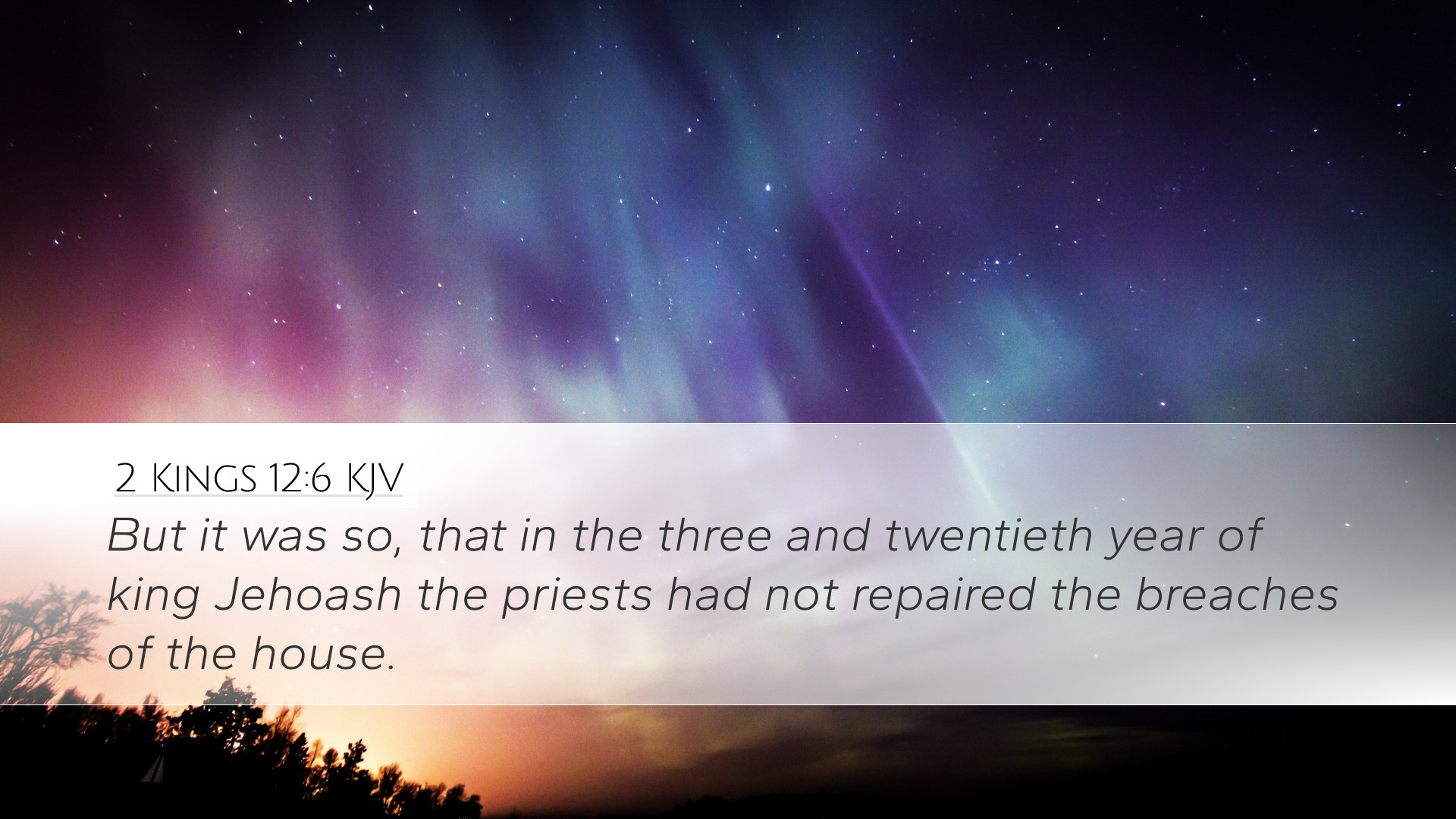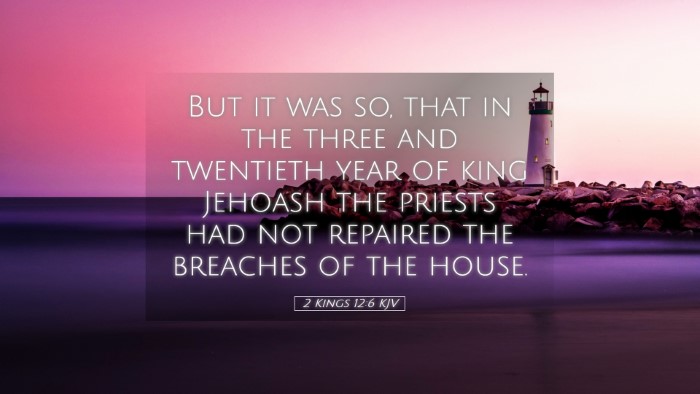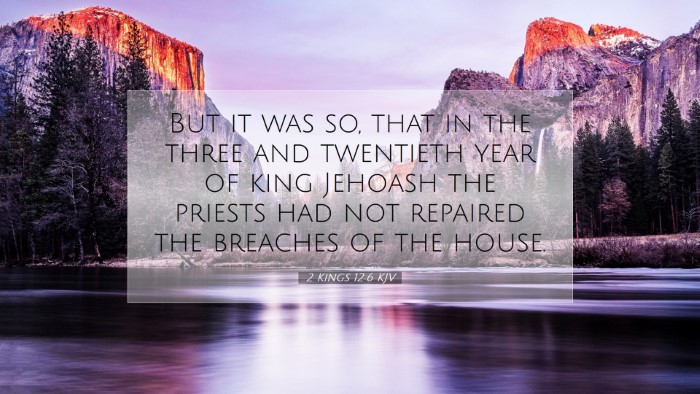Old Testament
Genesis Exodus Leviticus Numbers Deuteronomy Joshua Judges Ruth 1 Samuel 2 Samuel 1 Kings 2 Kings 1 Chronicles 2 Chronicles Ezra Nehemiah Esther Job Psalms Proverbs Ecclesiastes Song of Solomon Isaiah Jeremiah Lamentations Ezekiel Daniel Hosea Joel Amos Obadiah Jonah Micah Nahum Habakkuk Zephaniah Haggai Zechariah Malachi2 Kings 12:6
2 Kings 12:6 KJV
But it was so, that in the three and twentieth year of king Jehoash the priests had not repaired the breaches of the house.
2 Kings 12:6 Bible Commentary
Commentary on 2 Kings 12:6
Verse: "But in the twenty-third year of King Joash, the priests had not repaired the damages of the temple."
Introduction
The passage of 2 Kings 12:6 addresses a significant moment in the reign of King Joash, highlighting issues of stewardship and spiritual responsibility. It underscores the ongoing neglect of the Temple, which symbolizes the covenant relationship between God and His people. The comments drawn from esteemed public domain commentaries such as those by Matthew Henry, Albert Barnes, and Adam Clarke provide deep insights into this scripture, illuminating its spiritual and historical significance.
Contextual Background
To fully appreciate the significance of this verse, it's essential to understand the context. King Joash, who ascended the throne as a child, was notably a king who began his reign with noble intentions. Under the guidance of the priest Jehoiada, reforms were initiated to restore the worship of Yahweh and repair the Temple which had fallen into disrepair due to previous idolatrous kings.
Commentary Insights
1. Matthew Henry's Perspective
Matthew Henry emphasizes the delay in repairing the Temple as not merely a matter of physical restoration but as a reflection of the spiritual condition of the nation. He notes that the Temple, as the house of God, should have been prioritized, signifying the people's commitment to worship and covenant obligations. Henry points out that the neglect over such an extensive time revealed a lack of urgency and prioritization in the spiritual life of the leaders and people.
2. Albert Barnes' Observations
Albert Barnes provides a critical analysis of the administrative failures among the priests during Joash’s reign. He suggests that the priests were responsible for the oversight of the Temple’s condition and the spiritual life of the nation. Barnes notes that their failure to act resulted in significant spiritual ramifications, indicating a broader apathy towards God’s commands. He underscores the importance of accountability among spiritual leaders, suggesting that such neglect led to challenges in the community’s relationship with God.
3. Adam Clarke's Interpretation
Adam Clarke offers a more profound reflection on the spiritual implications of the neglect of the Temple. He correlates the physical condition of the Temple with the moral and spiritual decay of the people. Clarke draws attention to how the act of repairing the Temple was not merely a building project; it symbolized the restoration of a spiritual covenant with God. He suggests that the failure to repair could be seen as a metaphor for the people's broken relationship with God, reflecting their hearts' condition.
Theological Implications
The theological implications of 2 Kings 12:6 are multifaceted. The neglect of the Temple indicates a profound spiritual disengagement. In the context of the New Testament Church, the temple's physical structure is now seen as symbolic of the body of believers. Thus, this passage serves as a reminder for contemporary believers to consider the "temple" of their spiritual lives and communal worship, ensuring that they prioritize their relationship with God above all else.
Lessons for Leaders and Congregations
- Prioritization of God's House: The maintenance of spiritual practices and communal worship must take precedence, reflecting a deep commitment to God.
- Accountability among Leaders: Spiritual leaders must be vigilant and proactive about the spiritual and physical well-being of the church community.
- Awareness of Spiritual Decline: Just as the priests allowed the Temple to fall into disrepair, modern congregations must remain alert to signs of spiritual neglect within their communities.
- Restoration as a Community Effort: Repairing the spiritual "temple" requires collective efforts, emphasizing the importance of community in fostering a vibrant faith.
Conclusion
In conclusion, 2 Kings 12:6 serves as both a historical account and a poignant reminder of the continual need for vigilance in spiritual stewardship. Insights from Matthew Henry, Albert Barnes, and Adam Clarke reveal a deeper understanding of the responsibilities of leaders and the community in maintaining a sacred space for God’s presence. The implications of this verse challenge both contemporary pastors and congregations to engage actively in the life of their faith community and ensure that the "temple" remains a vibrant expression of their relationship with God.


